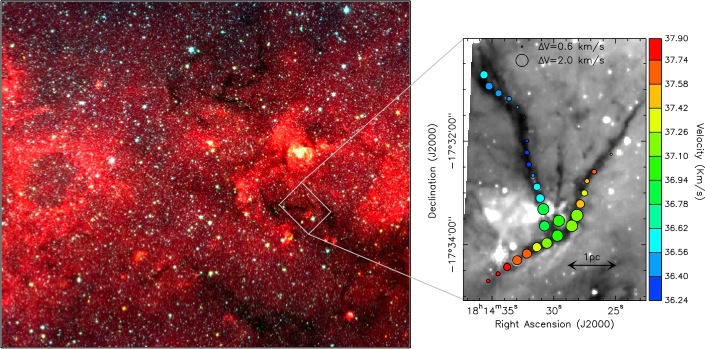News
Channelling the flow: A key to the formation of super-Suns
One of the central issues in understanding how stars form is how the massive clouds of gas and dust in which stars form fragment to produce the direct progenitors of individual stars. An international team of astronomers has used the 30m telescope of the Institut de Radioastronomie Millimetrique in Spain in order to shed new light on this long-standing issue for stars more than 10 times the mass of our Sun.
Observing the structure and motion of a set of infrared dark interstellar filaments, the researchers have found for the first time clear evidence that infalling streams of dense gas can set the conditions for the formation of super-Sun progenitors.
 |
| (left) Mid-Infrared Spitzer/GLIMPSE (Benjamin et al. 2003; Churchwell et al. 2009) composite image of the region surrounding SDC13. A number of dark features, known as Infrared Dark Clouds, can be seen on this image. SDC13 is located within the grey rectangle. (right); The 8micron Spitzer image of SDC13 is displayed in grey scale, while the coloured symbols represent the dense gas velocity (colour) and the corresponding internal motions (size of the symbol). |
Stars form in some of the coldest (~10 Kelvin, -260 Celsius) regions of the Universe, deep inside large clouds of molecular gas. Observations at wavelengths from the far-infrared to millimetre of star-forming regions have revealed that these clouds are sub-structured into complex networks of clumps, filaments and cores. It is these central cores which are the direct progenitors of individual stars. Despite their importance, how these cores form and evolve remains unclear in several aspects. In particular the temperature of these cores is too low to prevent them from fragmenting into small pieces. A different source of pressure support is therefore necessary to form super-Sun progenitors.
The region which has been investigated is called SDC13 and is located at 3.6kpc (12 000 light years) from the Sun. It consists in a small network of infrared dark filaments whose total mass ~1000 time the mass of our Sun. The darkness of these dense filamentary clouds ensures that the initial conditions for the formation of stars are still imprinted in the gas properties. The
observations reveal the presence of two intermediate-mass cores, ~80 solar masses each, sitting at the junction of the long dark filaments. Complementary observations obtained with the IRAM 30m telescope further showed that the gas within the filaments exhibits correlated velocity and internal motion gradients, the largest internal motions being measured at the centre of the system, near the cores.
Comparison with a simple model suggests that these filaments are collapsing along their length. The effect of this collapse is two-fold. First it channels material to the centre of the system and the cores. In addition, it provides the energy that allows super-Sun progenitor cores to form.
Nicolas Peretto (Cardiff University), the project leader, says :"This finding is very exciting. It bridges the gap between what we know about the formation of solar-type stars and the formation of the most massive stars in the Galaxy. As we find and study more and more massive progenitors it seems that the impact of large-scale gas dynamics becomes increasingly important. These results point towards a picture of star formation which lies between the models which researchers have been arguing over for the past decade."
Collaborator Gary Fuller (University of Manchester) says "The clear-cut connection between the velocity and internal motions is remarkable. It clearly shows the mechanisms at work in forming the progenitors of massive stars."
More information:
The paper has been recently published by A&A and can be found here.
Contact scientist : Nicolas Peretto

